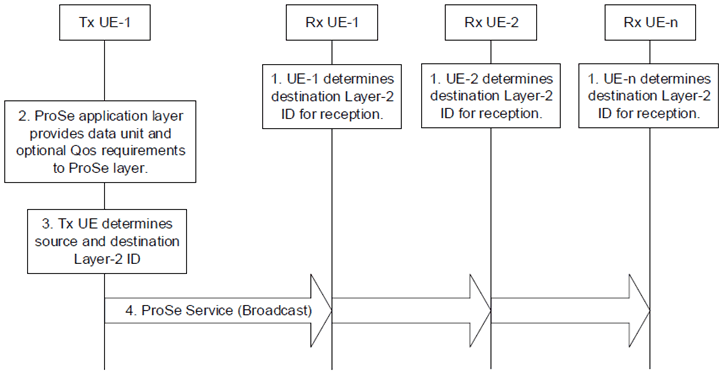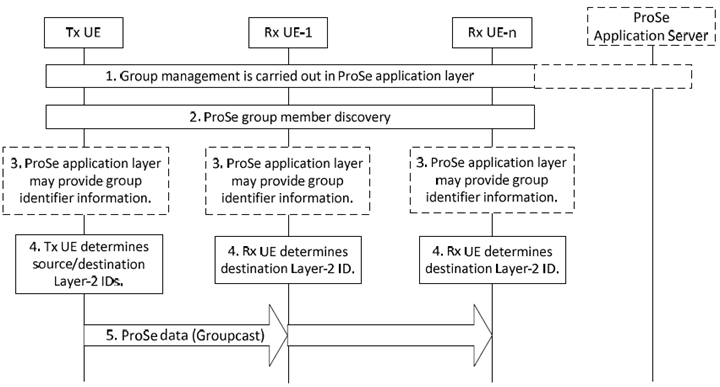Content for TS 23.304 Word version: 19.0.0
1…
4…
4.2.3…
4.2.7…
4.3…
5…
5.1.4…
5.1.5…
5.2…
5.3…
5.4…
5.5…
5.6…
5.7
5.8…
5.9…
6…
6.1.2…
6.2…
6.3…
6.3.2…
6.3.2.3…
6.3.2.4…
6.4…
6.4.3…
6.5…
6.5.2…
6.6…
6.7…
6.7.2…
6.8…
7…
7.2…
6.4 5G ProSe Direct Communication
6.4.1 Broadcast mode 5G ProSe Direct Communication
6.4.2 Groupcast mode 5G ProSe Direct Communication
...
...
6.4 5G ProSe Direct Communication p. 93
6.4.1 Broadcast mode 5G ProSe Direct Communication p. 93
To perform 5G ProSe direct communication over PC5 reference point in broadcast mode operation, the UE is configured with the related information as described in clause 5.1.3.
Figure 6.4.1-1 shows the procedure for broadcast mode of 5G ProSe direct communication over PC5 reference point.

Figure 6.4.1-1: Procedure for Broadcast mode of 5G ProSe direct communication over PC5 reference point
(⇒ copy of original 3GPP image)
(⇒ copy of original 3GPP image)
Step 1.
The ProSe layer of receiving UE(s) determines the following for the broadcast mode communication reception:
Step 2.
- the destination Layer-2 ID for broadcast reception as specified in clause 5.8.2.2;
- the PC5 QoS parameters for this broadcast ProSe service as specified in clause 5.6.1; and
- the NR Tx Profile based on the configuration as specified in clause 5.1.3.1.
The transmitting UE ProSe application layer provides data unit and may provide ProSe Application Requirements specified in clause 5.6.1 to ProSe layer.
Step 3.
The ProSe layer of transmitting UE determines the following for the broadcast mode communication transmission:
Step 4.
- the destination Layer-2 ID for broadcast as specified in clause 5.8.2.2;
- the PC5 QoS parameters for this broadcast ProSe service as specified in clauses 5.6.1; and
- the NR Tx Profile based on the configuration as specified in clause 5.1.3.1.
The transmitting UE sends the ProSe data using the source Layer-2 ID and the destination Layer-2 ID.
6.4.2 Groupcast mode 5G ProSe Direct Communication p. 94
Figure 6.4.2-1 shows the procedure for groupcast mode of 5G ProSe Direct Communication.

Figure 6.4.2-1: Procedure for groupcast mode 5G ProSe Direct communication
(⇒ copy of original 3GPP image)
(⇒ copy of original 3GPP image)
Steps 1 to 3 are optional, e.g. applicable for Application Layer managed group. Groupcast mode ProSe Direct communication can be performed without steps 1 to 3 based on the provisioned parameters as defined in clause 5.1.3.1.
Step 1.
ProSe Group management is carried out at ProSe application layer. This may be performed in coordination with ProSe Application Server.
Group Member Discovery parameters as specified in clause 5.1.2.1 can be provisioned in ME from PCF or configured in UICC or provided from ProSe Application Server to the UE.
Step 2.
Each UE may perform a ProSe group member discovery (similar to the procedures in clause 6.3.2.2) that is restricted only to users sharing the same Application Layer Group ID obtained in step 1.
The Application layer discovery messages including the Application Layer Group ID for Application Layer managed group may be exchanged between UEs to discover each other sharing the same Application Layer Group ID. When the group is formed, the Application layer discovery message including group size and member ID may be provided by one UE to all other UEs. The Application layer discovery messages may be included as metadata in a PC5 direct discovery message.
Step 3.
The ProSe Application layer may provide group identifier information (i.e. the Application Layer Group ID discovered based on discovery messages exchanged in step 2) as specified in clause 5.8.2.3.
The ProSe application layer may also provide ProSe Application Requirements for this communication.
If the ProSe application layer does not provide ProSe Application Requirements, the ProSe layer determines the PC5 QoS parameters based on the mapping of ProSe service to PC5 QoS parameters as specified in clause 5.1.3.1.
The ProSe application layer may provide a group size and a member ID (optionally based on discovery messages exchanged in step 2) as specified in clause 5.3.3 for Application Layer managed group.
Step 4.
The ProSe layer of transmitting UE self-assigns a source Layer-2 ID and determines the following for the groupcast mode communication transmission:
Step 5.
- a destination Layer-2 ID as specified in clauses 5.8.2.1 and 5.8.2.3.
- The PC5 QoS parameters for this groupcast mode communication as specified in clause 5.6.1.
- the NR Tx Profile based on the configuration as specified in clause 5.1.3.1.
- destination Layer-2 ID as specified in clauses 5.8.2.1 and 5.8.2.3;
- the PC5 QoS parameters for this groupcast mode communication as specified in clause 5.6.1; and
- the NR Tx Profile based on the configuration as specified in clause 5.1.3.1.
Transmitting UE sends the ProSe data using the source Layer-2 ID and the destination Layer-2 ID.